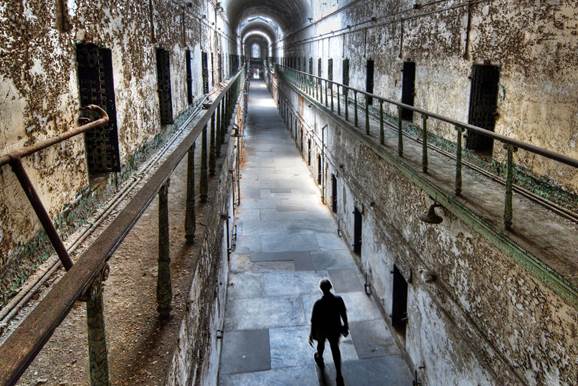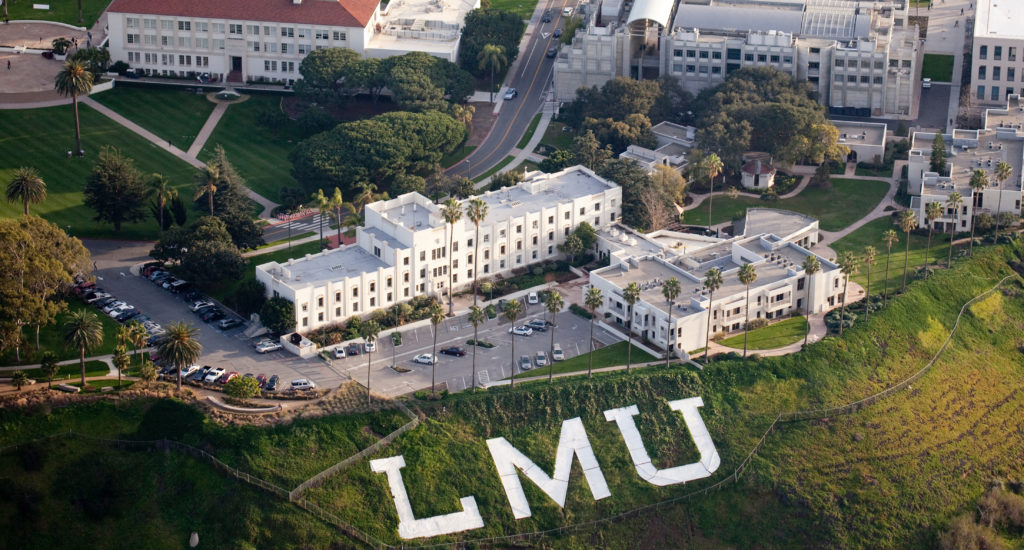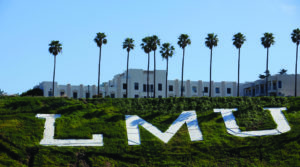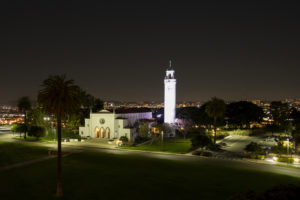Faculty Senate President Dorothea Herreiner talks to Elizabeth Drummond, associate professor of history and chair of the department, about the transition to teaching in an online environment and her course “Telling History in Public.” Drummond, who has taught at LMU since 2006, previously served as president of the LMU Faculty Senate and the BCLA College Council.
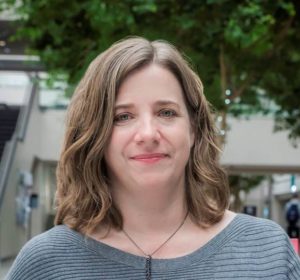
Dorothea Herreiner: What is the course about and what are your goals when teaching the course for someone not familiar with your field?
Elizabeth Drummond: “Telling History in Public,” HIST 2910, is one of the History Department’s 2000-level seminars, a lower-division seminar, required for the major, which introduces students to the study of history, including historical methods, the writing of history, and historical interpretation. I teach it through the lens of public history, a sub-field that deals with those aspects of historical work that engage the public with the past. So, the course is a methods course, but one that approaches the teaching of historical thinking by focusing on a specific problem or issue – in this case, the history of policing, prisons, and mass incarceration, exploring how prisons and other carceral institutions have become sites of public history and memory; how the history of mass incarceration is presented in exhibitions, films, and online; and how an understanding of history can inform a variety of public policy discussions, for example, debates about police and prison abolition. My goals for the course relate to both content and skills. I want to get students thinking about the public uses of the past, especially around what we might call “difficult histories,” in particular, for this semester, the history of policing, punishment, and prisons. I also want to get students practicing the craft of history, in particular public history. But another goal is to create space for students to develop their own learning goals for the course, to explore what ignites their curiosity and to research issues of interest to them.
DH: What are some important disciplinary-specific aspects of this course?
ED: This is a methods course, so it is focused on cultivating students’ abilities to think historically, to undertake historical research, and to present and defend historical arguments. For our discussions, we read and analyze secondary sources as a means to understand the nature of historical interpretation and argumentation. We also analyze examples of public history in a variety of different forms, including exhibitions in museums and at historic sites, websites, Digital Humanities projects, graphic histories, podcasts, film, and journalism. For their research projects, students identify appropriate primary and secondary sources, read and analyze them, and then develop their own historical interpretations and arguments, using evidence from the sources to support their claims. Within the discipline of history, we’re also focusing specifically on the field of public history, including debates about audience, shared authority, and representation. We’re exploring how we think about, interpret, remember, and represent the past for the broader public, how we translate complex historical narratives for a broader non-specialist audience, as well as how historical narratives are presented and deployed by non-historians.
DH: What are some main lessons you learned from the spring, summer, or before about teaching online?
ED: For quite some time now, I’ve been engaged in a process of re-thinking my pedagogy in ways that have been transformative for me as a teacher and, I hope, for my students. The first step in this process was to hack my syllabus, which with all of its policy statements had become increasingly – from my perspective – hostile to students. I’ve experimented with the visual design of my syllabus but have also, more substantively, moved away from thinking about the syllabus as a contract in which all of the terms and conditions are spelled out, to thinking of it as an “invitation to learning.” That shift in my thinking has meant a shift from including a lot of policy statements focused on policing student behavior or outlining penalties on the syllabus, to a focus on providing information about resources to support student learning and embracing a generous and flexible approach, with the goal of empowering students in their own learning. More recently, I’ve adopted an approach to evaluating student work that many people call ungrading, something that I first learned about from Jesse Stommel. Rather than give letter or number grades for individual assignments, I provide feedback, ask questions, and make comments that engage students’ work. The goal is to put the focus on learning, not merely on getting a grade. I mention all this, because I’ve found this transformation of my own teaching to be even more important in the context of the shift to online, as well as in the broader context of COVID, climate change, economic crisis, and political polarization, and rising authoritarianism. The unique challenges of online learning, overlaid on the normal challenges of deeply engaging with complex historical issues, and doing it all in these specific times, makes it even more important, for me, that I embrace flexibility and ground my teaching in generosity, compassion, and respect for students – what Cate Denial calls a “pedagogy of kindness.”
DH: What are some main differences between teaching this course in person and teaching it online/remotely?
ED: The course is a discussion- and projects-based course, so the challenge is translating that kind of collaborative spirit into the online setting. When I teach this course in person, our class meetings focus on discussing the assigned readings as a group, digging into the key issues, and then on doing hands-on activities, both breaking down the research process and working together on group projects. Last fall, the students curated an exhibition about LMU history using documents and artifacts from University Archives, a kind of project that is simply not possible this year. In the online environment one of my main goals is to foster the sense of community that so characterizes the classroom and that is the foundation for successful collaboration. Fortunately, there are a variety of digital tools that enable us to do digital public history projects.
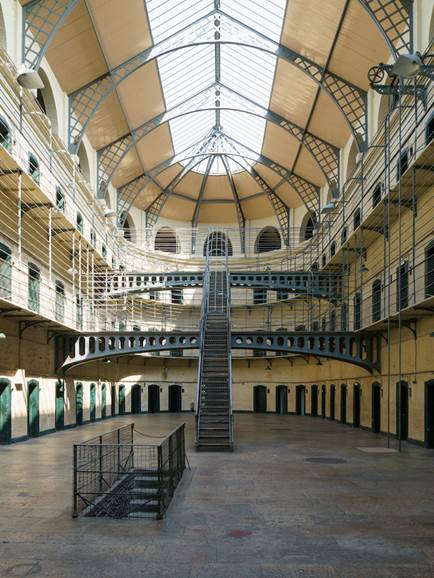
DH: What are some new elements that you introduced into the course due to the online environment?
ED: I’ve long incorporated digital tools and projects in my classes, having my students do digital timelines, storymaps, websites, virtual exhibitions, and the like. But I’ve introduced two new elements with this shift online, mainly to address the concerns about how to foster community and collaboration that I just mentioned. To encourage close reading of texts, I’ve been using the social annotation tool, Hypothes.is, which is integrated in Brightspace. It allows students to highlight and comment on assigned readings and to respond to one another, a kind of group read. And then I’ve been using Microsoft Teams for discussions and general communications, and I strongly prefer it to the discussion boards on Brightspace, as it’s more similar to the kind of chat and text that we do all the time. Finally, as part of my ongoing re-imagining of my syllabus, I’ve added bitmoji versions of me to it, as visual markers for different parts of the syllabus, and have also created a “living” version of the syllabus as an online storymap.
DH: What are you most excited about in this course this semester?
ED: I chose the thematic focus for this iteration of HIST 2910 last fall, to connect with the Bellarmine Forum on transformative justice. Policing, mass incarceration, and prisons have been at the forefront of the news for a while now, so the course was already going to be focused on a difficult history and issues of great importance for today’s society. The resurgence of the Black Lives Matters protests and calls for police abolition have made the class even more current, and I’m excited to see how students bring the study of history to bear on these issues. I’m also really excited about the History Department’s “Punishment & Prisons, Dungeons & Dark History” event in a couple of weeks, which will bring together a scholar of medieval legal history and a museum educator from Eastern State Penitentiary to talk about some of these issues.
DH: What would you like to suggest to your students for taking courses in the fall?
ED: I know that it might seem hard given all that is going on right now but have fun! College is the place where you get to explore, where the curiosity door is not only unlocked but wide open. Go through it! And then also, be generous with yourself. What I mean by that is that it’s OK to take breaks when things feel overwhelming; even better, take breaks before they feel overwhelming. Show yourself some forgiveness for mistakes. LMU has a lot of resources to support you; seek them out. Talk to your professors and get to know them, and let them get to know you.
